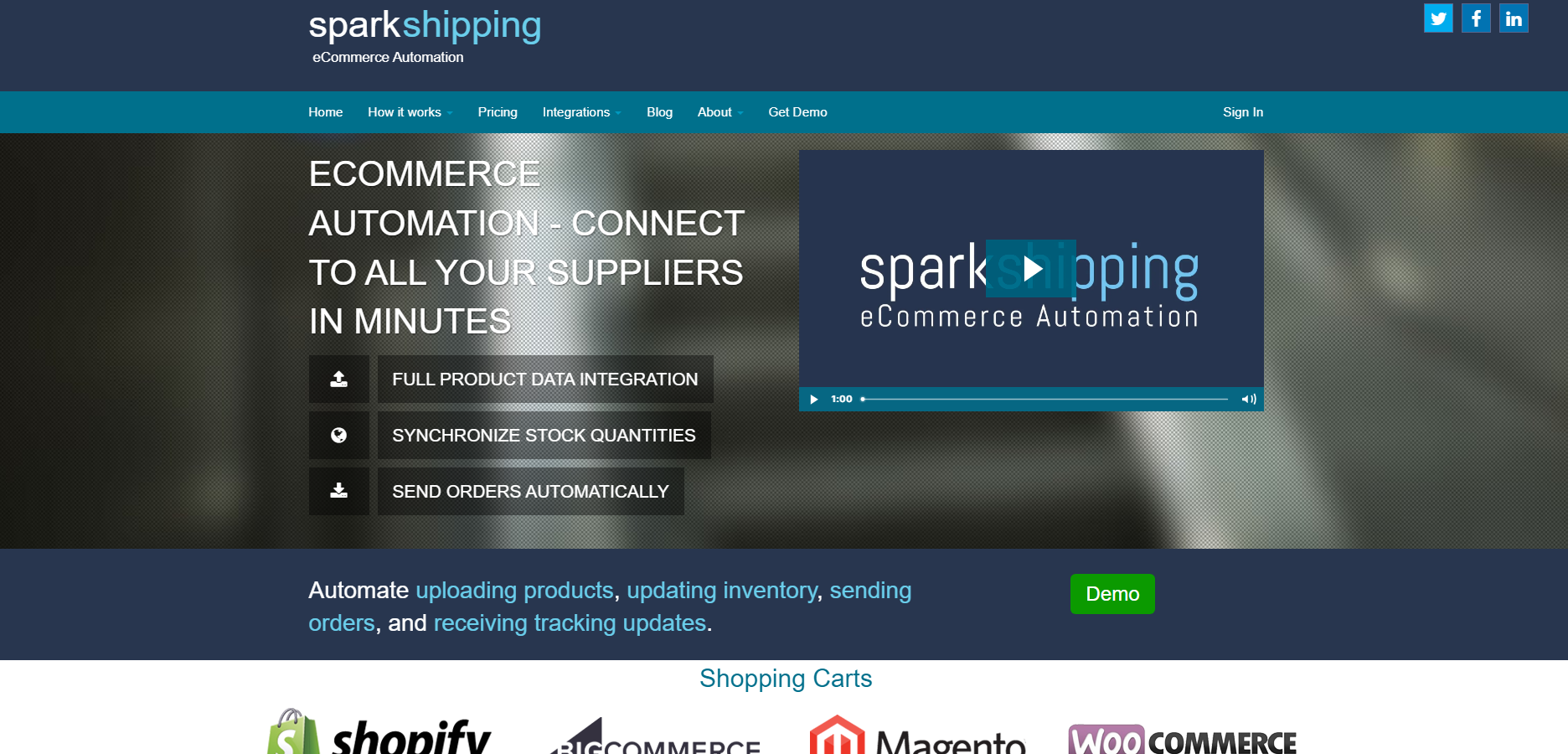EDI vs API: Choosing the Best Option for Your Trading Partners

Vendor relationships are everything when you run an online store.
As an eCommerce pro, you’re all too familiar with the vendor onboarding process.
It’s hard enough to find a trustworthy supplier, but you also need to iron out the logistics of working with this new vendor.
Most vendors use some kind of digital solution to transmit data and process orders for their customers. EDI and API are two of the most common ways to do this.
But if your vendor says, “We use EDI” or “We use API,” and those words sound like gibberish, don’t sweat it!
This guide will explain what EDI and API mean, as well as their pros and cons.
We’ll also detail the differences between the EDI and API technologies and share a huge time-saving hack to help you avoid the hassles of choosing between EDI and API.
What Is EDI?

EDI stands for Electronic Data Interchange and is a standardized method for exchanging data electronically between business partners.
Electronic data interchange facilitates the transfer of business documents and data from one computer system to another—all without manual intervention.
For example, if you want to place an order with an external trading partner, there’s no need to make a phone call or send an email.
All you need to do is submit an order online, and the vendor’s EDI system will translate it into a standardized format that they use to fulfill the order.
Easy, right?
It might sound high-tech, but electronic data interchange has actually been around for decades.
It has a long history in the logistics industry for supply chain processes, but your eCommerce suppliers might use it, too, especially for retail.
Pros
- Streamline business processes: Electronic data interchange eliminates a lot of manual processes, which speeds up transactions while reducing errors.
- EDI integrations: Once you set up an EDI integration, it gives you a robust system for handling mass data exchanges. You can exchange bulk data with your supplier because the EDI is designed to handle these large transfers.
- Works with a lot of trading partners: Plenty of eCommerce suppliers use EDI because it creates a shared language for trading partner communications. There’s no need to fuss with manual data exchanges. As long as your trading partners follow EDI, following this system sets you up for consistency across all suppliers.
Cons
- Maintenance or translation services: The downside to EDI is that it requires some pretty specific formatting to work correctly. You might need to use what’s called a translation service to convert your orders into the proper data formats for each supplier's unique systems.
- Integration challenges: It takes a lot of work to integrate EDI technology with several systems at once. It’s an older technology, so some new systems won’t even support it.
- Cost: EDI integration can take a lot of time and money to set up at first. You’ll need to buy several software solutions to manage everything, so think carefully before committing to EDI.
You can get around this by following your supplier’s setup to a tee, but this workaround falls apart if you buy from multiple trading partners with different standards.
Best For
- Large volume transactions: EDI can handle mass data transfers with no problem. If you place a lot of bulk orders, it could be the best fit for your biz.
- Recurring and scheduled data transfers: This is best for retailers with predictable demand. You can set up EDI to send daily purchase orders to trading partners at a specific time, which is a big time-saver.
- Long-term business relationships: It takes time to set up EDI, so it doesn’t make sense to set it up for a one-time partnership.
- Integrating with legacy systems: API integration is better for modern systems. But if you’re using legacy software that doesn't support APIs, EDI is probably the better fit.
- Security: EDI protocols have robust security features that protect sensitive business transactions and financial data.
What Is an API?

API stands for application programming interface. This is a newer and more modern way to do data transmission. APIs are gaining popularity because they allow real-time data exchange between multiple systems.
For eCommerce, your trading partners will give you an API. When a shopper places an order in your store, the API automatically sends the request to the supplier’s system in real-time.
This API call includes all details about the order, which the supplier’s system uses to confirm product availability. If everything looks good, your supplier starts the fulfillment and shipping process.
Pros
- Real-time access: APIs support real-time data exchange, which EDI just isn’t equipped to offer. Their speed makes them ideal for tasks that require immediate exchanges, like stock checks.
- Flexibility: API technologies easily integrate with multiple systems, including cloud SaaS platforms. They’re much more flexible, too, so you're free to use a mix of different technologies for your store.
- Simple implementation: Your supplier provides the API, and your store quickly connects to it. This is super fast and works with a variety of platforms, so API is ideal for quick setups.
Cons
- Cost: Depending on how you use it, there could be costs associated with API calls. It costs money to transfer data through an API, so your vendor may limit how many calls you can make to the API per day.
- Complexity: APIs are simpler than EDI solutions, but you still need a basic understanding of the technology before you use it. You also need a good idea of the platform you’re integrating with, so you may need to hire a developer to set everything up at first.
- Security: APIs are easy to access, which is great for speed but bad for security. You need proper measures in place to prevent breaches through the API.
Best For
- Real-time data exchange: If you need immediate, up-to-date information like stock checks, price updates, and shipping status, API is the way to go.
- Modern systems: APIs are the better choice if you already use state-of-the-art tech to manage your eCommerce platform. They easily integrate with mobile apps and cloud SaaS tools like payment gateways, analytics, and customer relationship management (CRM) software.
- Scalability: If you plan to grow your business, APIs are more scalable. If you suddenly need to place larger orders, the API can scale up without requiring an entire system overhaul.
- Speed: An EDI connection takes time, but APIs are generally faster to set up. If your vendor offers an API, you can start selling their products quickly.
EDI vs API: The Main Differences

EDI and API each have their pros and cons—there’s no clear winner.
If you’re trying to choose between different suppliers who use either EDI or API, it’s important to understand the differences between EDI and API.
-
History: EDI originated as far back as the 1960s for retail businesses. APIs are a more modern approach that multiple industries rely on to exchange data.
-
Communication methods: EDI is primarily asynchronous, so it doesn’t happen in real time. Instead, it batch processes large datasets at scheduled intervals.
APIs, on the other hand, are usually synchronous, and updates happen in real-time.
-
Flexibility: EDI is robust, but it isn’t as flexible because it relies on rigid standards like EDI 846 and EDI 856. This is why it doesn’t play nicely with new technologies. APIs are highly flexible and integrate with a multitude of platforms and systems.
-
Data format: EDI uses a structured, standardized data format, but some industries have EDI standards for uniformity. APIs are more versatile; they can handle XML, JSON, and other formats and automatically adjust depending on the systems they connect with.
-
Setup: Both options can have pretty complex setup processes, but this depends on your current setup and what your business partners need. EDI usually requires specialized software to translate data between two EDI systems. APIs don’t need this and usually come with tools that simplify implementation.
-
Security: EDI might be an older technology, but it’s definitely more secure. It allows you to use value-added networks (VANs) for extra security, which makes it ideal for large stores that want to lock down their data. APIs, on the other hand, don’t have such robust security. You’ll need to monitor them often and stay on top of security updates.
Simplify Integrations With the Right eCommerce Software

For business executives responsible for making decisions, it might feel like a big task to choose between EDI and API technologies. The good news is that you don’t have to limit yourself to one technology or one type of vendor.
Platforms like Spark Shipping offer seamless EDI and API integration, so there’s no need to worry about file compatibility or integration—just connect your account to your vendor’s system and you’re ready to start selling.
Spark Shipping has over 150 vendors in our system, but the platform also supports custom integrations.
Check out our vendor integrations to skip the EDI vs API debate and streamline your eCommerce business.
Popular Posts
Posts by Topic
- Dropshipping (5)
- Dropshipping Automation (4)
- Dropship Suppliers (3)
- EDI (3)
- Pricing Strategy (3)
- Amazon Seller Central (2)
- Conversion Rate Optimization (2)
- Dropshipping Products (2)
- Order Management (2)
- Vendor Product Catalog (2)
- Dean Soto (1)
- Feature Announcement (1)
- Online Empire Academy (1)
- Product Optimization (1)
- Shipping (1)
- referral marketing (1)